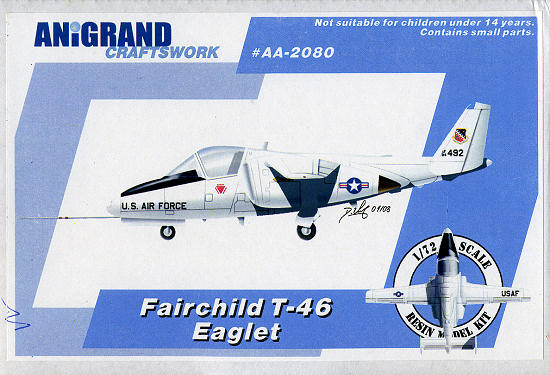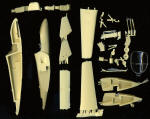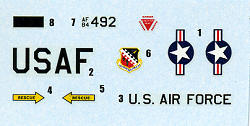
| KIT: | Anigrand 1/72 T-46 'Eaglet' |
| KIT #: | AA 2080 |
| PRICE: | $49.00 MSRP from www.NostalgicPlastic.com |
| DECALS: | One option |
| REVIEWER: | Scott Van Aken |
| NOTES: | Resin kit |

| HISTORY |
The Fairchild T-46 (nicknamed the "Eaglet") was an American light jet trainer aircraft of the 1980s. It was cancelled in 1986 with only three aircraft being produced.
In order to validate the proposed aircraft's design, and to explore its flight handling characteristics, Fairchild Republic contracted with Ames Industries of Bohemia, New York to build a flyable 62% scale version. Burt Rutan's Rutan Aircraft Factory (RAF) in Mojave, California was contracted to perform the flight test evaluations, with test pilot Dick Rutan doing the flying. The scale version was known at RAF as the Model 73 NGT.
The plane was the winner of the US Air Force's competition to build the Next Generation Trainer (NGT) program to replace the Cessna T-37 Tweet. The aircraft first flew on October 15, 1985, but was cancelled a little more than a year later, for reasons that largely remain controversial. The T-46 was the last project of the Fairchild Republic Corporation, and after the program termination it had no more income. Without any new contracts and the NGT program cancelled, the company closed the Republic factory in Farmingdale, New York, bringing 60 years of Fairchild aircraft manufacturing to an end.
The aircraft itself featured a side by side configuration, a twin (or "H") tail (similar to the company's A-10), ejection seats, pressurization, and two turbofan engines. Had it gone into full production the NGT program called for over 600 aircraft being built up to 1993. There was potential for some overseas sales as well, such as in the light ground attack role in addition to its role as a trainer.
A remaining T-46 can be seen at the Air Force Flight Test Center Museum at Edwards Air Force Base, California, and in the boneyard at Davis Monthan AFB in Tucson, Arizona.
| THE KIT |
 Molded in Anigrand's usual tan resin, the kit has nicely engraved panel lines. The one piece flight surfaces will make building a bit easier than most with the wings and fins provided with pins/sockets for proper alignment. The cockpit is equipped with two ejection seats, two control sticks and an instrument panel with built in dash panel. There isn't a ton of room for nose weight and this kit will need all it can get. The nose wheel is molded in place with the nose gear so should supply enough support for the kit. As you can see, parts clean-up will consume some time as will fixing the usual air holes, especially those on the wing tips. A one piece clear resin canopy is provided. It could use a dunk in Future to increase its clarity and my sample had some sort of detritus in the resin around the canopy/windscreen that cannot be removed.
Molded in Anigrand's usual tan resin, the kit has nicely engraved panel lines. The one piece flight surfaces will make building a bit easier than most with the wings and fins provided with pins/sockets for proper alignment. The cockpit is equipped with two ejection seats, two control sticks and an instrument panel with built in dash panel. There isn't a ton of room for nose weight and this kit will need all it can get. The nose wheel is molded in place with the nose gear so should supply enough support for the kit. As you can see, parts clean-up will consume some time as will fixing the usual air holes, especially those on the wing tips. A one piece clear resin canopy is provided. It could use a dunk in Future to increase its clarity and my sample had some sort of detritus in the resin around the canopy/windscreen that cannot be removed. 
Instructions are well done with a history of the plane and painting/markings guide on one side, and three photo-realistic drawings on the other side to help with construction. Two small decal sheets are provided (one is shown and they are both the same) to give markings for one of the three prototypes. It would have been nice to have been given the option to do any one of the three and those who wish to do so can easily change out the last digit in the serial with a marking from the spares box.
| CONCLUSIONS |
A very neat little kit that should provide a relatively quick build. It is nice to see these subjects being produced and I look forward to what is coming down the pike. As a closing note, Anigrand is starting to use new boxing with an open top and I'm very pleased to see it.
| REFERENCES |
http://en.wikipedia.org June 2008
Thanks to www.NostalgicPlastic.com for the preview kit. Get yours today and get free shipping in the US.
If you would like your product reviewed fairly and fairly quickly, please contact the editor or see other details in the